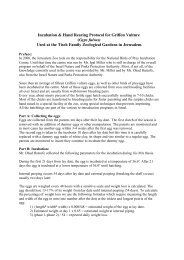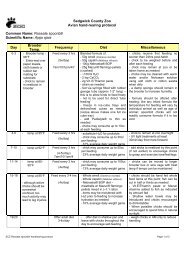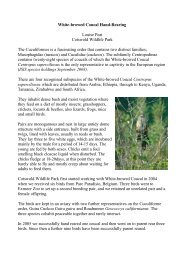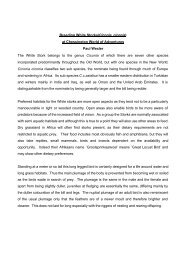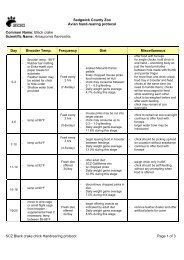Griffon Vulture Husbandry Manual - Avian Rearing Resource
Griffon Vulture Husbandry Manual - Avian Rearing Resource
Griffon Vulture Husbandry Manual - Avian Rearing Resource
You also want an ePaper? Increase the reach of your titles
YUMPU automatically turns print PDFs into web optimized ePapers that Google loves.
Suggested <strong>Husbandry</strong> <strong>Manual</strong> for <strong>Griffon</strong> <strong>Vulture</strong>s<br />
This chapter aims to define the special needs of the captive <strong>Griffon</strong> <strong>Vulture</strong> Gyps<br />
fulvus. The information in this paper should be used in combination with the content<br />
of the more general husbandry guidelines for Falconiformes, such the one written by<br />
Jemima Parry-Jones "Management Guidelines for the Welfare of Zoo Animals-<br />
Falconiformes" and others.<br />
Group size:<br />
<strong>Griffon</strong> vultures can benefit from being in a group. Groups of 2.2 and above<br />
(depending on the size and shape of the enclosure) will allow a choice of mates, and<br />
will promote social dynamics within the group. With groups consisting of breeding<br />
age individuals, if pairs are not formed within two years, it is possible to<br />
change/exchange individuals within the group to stimulate breeding behaviour.<br />
Enclosure size and shape:<br />
There are several points that should be emphasised when planning a <strong>Griffon</strong> vulture<br />
exhibit.<br />
a) <strong>Vulture</strong>s need height, both for perching and nesting. Although distance from<br />
the public is important, many <strong>Griffon</strong>s will sit close to the front of their<br />
enclosures if they are able to perch much higher (>4m) than the viewing<br />
public.<br />
b) At least one side of the enclosure must be undisturbed by the public or keepers<br />
(i.e. no access or visibility).<br />
c) <strong>Griffon</strong> vulture enclosures can benefit from a steep wall with terraces made<br />
from natural or artificial rocks. The terraces or ledges should be constructed so<br />
that the <strong>Griffon</strong>s can make short leaps from one to the other.<br />
d) Logs used for perches should be placed at different heights. Different<br />
diameters of logs should be used and the surface of these perches should be<br />
rough and not smooth (old logs can be wrapped with ropes). <strong>Vulture</strong>s often<br />
stand on the ground and therefore need space to take off and land. Feeding<br />
areas should be kept free of obstacles.<br />
e) Regardless of whether rock ledges or wooden perches are used, the major<br />
consideration is enclosure height and position of the vultures when they are<br />
perched.<br />
f) Size: depth from the viewing public is important. For a group size of four<br />
<strong>Griffon</strong>s, a minimum reasonable enclosure size is 10m width*12m depth*5-<br />
7m height.<br />
g) A mixture of covered and uncovered areas is recommended, as vultures will<br />
often deliberately sit unprotected in the rain and will actively “sunbathe” with<br />
wings outstretched. However, there is a need to provide shelter from rain<br />
and/or summer sun.<br />
h) Potential breeding pairs should be given a choice of nest sites. For an<br />
enclosure containing 2.2 vultures, a selection of four nest sites is<br />
recommended.<br />
i) Breeding <strong>Griffon</strong>s can nest in either nest boxes or on open platforms/ledges.<br />
a. Nest boxes: can be made of plywood 1.2*1.2 m in size and 30cm in<br />
height (open top...). The floor of the nest box can be solid plywood<br />
with drainage or a thick and dense mesh. If the nest boxes are placed
near the visitors, it is recommended that the walls of the nest box<br />
facing the visitors should be built higher (1 m). The back of the nest<br />
box should either be held by the rear of the exhibit rockery or be<br />
blocked by 1 meter height plywood wall. This will allow the nesting<br />
pair to approach the nest box only from the front. A perch or a rockery<br />
built about one meter in front of the nest box and slightly above it will<br />
allow the <strong>Vulture</strong>s to stand near the nest box and either protect it,<br />
watch it (before jumping into it or while the partner sit in it) or declare<br />
it as the pair's nest place.<br />
b. Platforms: should be at least 1.5*1.5m, attached to the side of the<br />
aviary (to provide a solid wall on one side) and have one or two<br />
perches. It is important to add an edge around the platform, and to<br />
provide some nesting substrate such as a mixture of sand and wood<br />
shavings (5-10cm depth).<br />
j) Mesh can be made from welded or chain links metal with an eye/mesh size not<br />
exceeding 5*5 cm. In many places thick nylon netting (same eye/mesh size) is<br />
being used successfully.<br />
k) Bathing, preening and sunbathing make up a large part of the daily activity of<br />
vultures. Fresh water is essential, and should be available in a bath at least 1m<br />
in diameter and 10-20cm deep. <strong>Vulture</strong>s will often only bathe in or drink water<br />
that is changed virtually every day.<br />
l) Food can be placed on the ground, depending on the enclosure substrate. It is<br />
also possible to construct a large washable platform for feeding.<br />
m) Monitoring nests with video cameras is highly recommended.<br />
Food:<br />
• A diversity of food items is preferred. Whole carcasses or large animal<br />
parts (e.g. jointed beef) are preferred.<br />
• When using large herbivores carcasses, a cut in the belly should be done<br />
prior to feeding.<br />
• Chunks of meat (e.g. beef, horse, sheep, goats) can be used as long as they<br />
contain bones and bone pieces (about 1-3 cm pieces of bones should be<br />
placed near the food).<br />
• Whole rats and rabbits are good sources for a calcium/phosphorous<br />
balanced diet.<br />
• A weekly fasting day (or two) is necessary when the vultures are not<br />
raising chicks. Fasting days should follow a large feed on the previous day.<br />
• Great care should be taken that birds do not become obese. If food is<br />
regularly found uneaten after more than a day then overfeeding should be<br />
suspected and body condition monitored.<br />
• During the chick rearing period of the breeding season it is important to<br />
spread bone pieces (smaller than 1*1 sqcm) for the parents.<br />
Medical care:<br />
Two common problems that should be monitored and treated both medically and<br />
husbandry are Bumblefoot and Juvenile Rickets. Proper husbandry may prevent these<br />
problems.<br />
Although generally resilient, older vultures can have increasing problems coping with
Cold weather, and may also develop cardiac and/or renal disease. They may fail to<br />
thrive or develop frostbite lesions on their feet. Such birds may need to over-winter<br />
indoors.<br />
If a course of treatment is necessary, it should be noted that vultures are excellent at<br />
recognising drugs hidden in meat and rejecting them. It should also be noted that if on<br />
a course of oral drugs, birds should be handled and examined/ treated BEFORE drugs<br />
are given in food. Otherwise regurgitation and loss of the drug may result.<br />
Catching and restraining<br />
<strong>Griffon</strong> vultures are large, powerful birds with a pronounced beak. If handled<br />
incorrectly they are capable of inflicting significant injuries. Similarly, incorrect<br />
handling can easily cause injury to the bird.<br />
Compared with other raptors the talons of <strong>Griffon</strong>s are relatively weak for their size.<br />
However they do have a powerful grip, and although injury to a keeper is rare, caution<br />
must be exercised. The handler should primarily restrain the head.<br />
In general, two people are required to capture and restrain a <strong>Griffon</strong>. The first person<br />
should secure the head and neck immediately prior to the second person securing the<br />
wings, body and legs. Care must be taken not to throttle the bird. A vulture that is<br />
aware of the fact that it is to be captured will usually vomit, and this reaction is likely<br />
to continue during restraint. Care must be taken so that the bird does not inhale<br />
regurgitated food – which can cause choking or inhalation pneumonia. For veterinary<br />
treatment purposes, the regular capture and restraint of a vulture should be a last<br />
resort. Due to their vomiting reaction, birds will lose condition quickly if captured<br />
regularly. Similarly, a vulture kept isolated for treatment can become ‘depressed’<br />
(loss of appetite, lethargic behaviour, etc.)<br />
Incubation<br />
Incubation parameters are:<br />
Temperature: Day 1-21 from lay date 36.6<br />
Day 21-54 36.0<br />
Day 54 (internal piping) till full hatch 35.5-36.0<br />
Humidity: highly variable with an average of 40%rh<br />
Kw: 0.000548



